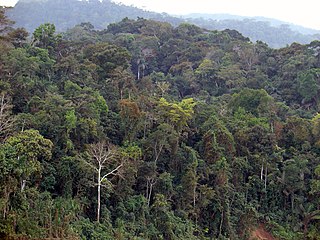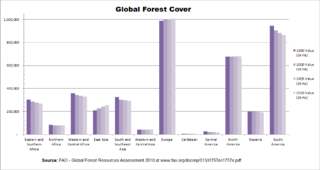
Deforestation in Laos is a major environmental concern, with Laos losing forest area to legal and illegal logging.

Deforestation in Laos is a major environmental concern, with Laos losing forest area to legal and illegal logging.
In 2020, more than 2,600 cubic metres of illegally harvested wood and over 290 tonnes of illicit timber were seized. Authorities inspected wood processing plants and found 2,788 were in violation of governmental restrictions. Some 1,636 plants which failed to operate lawfully were shut down. [1]
Timber products targeted for logging in Laos includes ironwood, mahogany, pine, redwood, and teak—and other forestry products—benzoin (resin), charcoal, and sticklac. [2]
The forest has also been an important source of wild foods, herbal medicines, and timber for house construction and even into the 1990s continues to be a valued reserve of natural products for noncommercial household consumption. Since the mid-1980s widespread commercial harvesting of timber for the export market has disrupted the traditional gathering of forest products in a number of locations and contributed to extremely rapid deforestation throughout the country. [2]
Slash-and-burn agriculture was practiced by approximately one million farmers in 1990. Slash-and-burn agriculture is highly destructive to the forest environment, because it entails shifting from old to new plots of land to allow exhausted soil to rejuvenate, a process that is estimated to require at least four to six years.
Government efforts to preserve valuable hardwoods for commercial extraction have led to measures to prohibit slash-and-burn agriculture throughout the country. Government restrictions on clearing forests for slash-and-burn cropping in the late 1980s, along with attempts to gradually resettle upland slash-and-burn farming villages to lowland locations suitable for paddy rice cultivation had significant effects on upland villages.

Timber resources have been commercially exploited on a small scale since the colonial period and are an important source of foreign exchange. In 1988 wood products accounted for more than one-half of all export earnings. In 1992 timber and wood products were almost one-third of the total principal exports. [2]
In the 1950s, forests covered 70 percent of the land area in Laos. By 1992, according to government estimates, forest coverage had decreased by nearly one-third, to just 47 percent of total land area. [2] As of 2021 [update] , governmental policy is to restore forest cover to 70 percent of the nation's landmass. [1]
Deforestation increased steadily throughout the 1980s, at an annual average rate of about 1.2 percent in the first half of the decade according to the United Nations (UN) and other monitoring agencies. This rate represents the destruction of about 150,000 to 160,000 hectares annually, as compared with annual reforestation of about 2,000 hectares. The government, however, reported a deforestation rate double this figure. Deforestation results from clearing forestland for shifting cultivation, removing logs for industrial uses and fuel, and the export of exotic hardwoods. [2]
The volume of logs (roundwood) removed for industrial purposes increased by about 70 percent between 1975–1977 and 1985–1987, to about 330,000 m3. However, this volume was dwarfed by that removed for domestic (fuel) purposes. Between 1980 and 1989, the volume of logs removed for fuel increased by about 25 percent, to about 3.7 million m3; only about 100,000 m3 were removed for industrial purposes. By 1991 these figures had increased to approximately 3.9 million m3 and 106,000 m3, respectively. [2]
Following the introduction of the New Economic Mechanism, decentralization of forest management to autonomous forest enterprises at the provincial level encouraged increased exploitation of forests. At the central and provincial levels, autonomous forest enterprises are responsible for forest management. [2]

The government moved to reconcile its opposing objectives of decentralized forestry management and environmental protection. In January 1989, the government imposed a ban on logging—initially announced in January 1988 as a ban on the export of unprocessed wood—although exemptions are granted on a case-by-case basis. This measure was followed by the imposition of high export taxes on timber and other wood products, included in the June 1989 tax reforms. [2]
Toward the end of 1989, logging was again permitted, but only based on quotas extended to individual forestry enterprises. In response to the restrictions, production of unprocessed logs, both roundwood or timber decreased slightly in 1989. [2] However, according to the Asian Development Bank, production more than recovered the following year. [2]
The effect of the restrictions is most clearly shown in the export statistics for 1989—exports of timber and wood products had decreased by 30 percent from the previous year. In 1991 a new decree banned all logging until further notice, in hopes of controlling widespread illegal logging and subsequent environmental destruction. However, there was little practical impact, and illegal logging remains widespread. The smuggling of logs to Thailand also is significant. [2]
Prime Minister Thongloun Sisoulith on 13 May 2016 issued Prime Minister's Order No. 15 which banned the export of unfinished wood products including timber and logs. [1]
The area of the Luang Prabang Range, at the border between Laos and Thailand, is allegedly rife with military involvement in the timber trade. [3]

Laos is an independent republic, and a landlocked nation in Southeast Asia, northeast of Thailand, west of Vietnam. It covers 236,800 square kilometers in the center of the Southeast Asian peninsula and it is surrounded by Myanmar (Burma), Cambodia, the People's Republic of China, Thailand, and Vietnam. About seventy percent of its geographic area is made up of mountain ranges, highlands, plateaux, and rivers cut through.

Illegal logging is the harvest, transportation, purchase or sale of timber in violation of laws. The harvesting procedure itself may be illegal, including using corrupt means to gain access to forests; extraction without permission, or from a protected area; the cutting down of protected species; or the extraction of timber in excess of agreed limits.
This article is the index of forestry topics.

Deforestation in Thailand refers to the conversion of its forested land to other uses. Deforestation numbers are inexact due to the scope of the issue. According to the Royal Forest Department (RFD) in 2019, Thai forests cover 31.6% of Thailand's landmass. The department claims that forest coverage grew by 330,000 rai in 2018, an area equivalent in size to the island of Phuket. A year earlier, an academic claimed that, since 2016, forested area has declined by 18,000 rai, a significant improvement over the period 2008–2013, when a forested million rai were lost each year. In 1975, the government set a goal of 40% forest coverage—25% natural forest and 15% commercial forest—within 20 years. To achieve that target in 2018, 27 million rai would have to be afforested.

Peruvian Amazonia is the area of the Amazon rainforest included within the country of Peru, from east of the Andes to the borders with Ecuador, Colombia, Brazil and Bolivia. This region comprises 60% of the country and is marked by a large degree of biodiversity. Peru has the second-largest portion of the Amazon rainforest after the Brazilian Amazon.

Cambodia is one of the world's most forest endowed countries that has not yet been drastically deforested. However, massive deforestation for economic development threatens its forests and ecosystems. As of 2015, the country has one of the highest rates of deforestation in the world.

Forestry in India is a significant rural industry and a major environmental resource. India is one of the ten most forest-rich countries of the world. Together, India and these other 9 countries account for 67 percent of total forest area of the world. India's forest cover grew at 0.20% annually over 1990–2000, and has grown at the rate of 0.7% per year over 2000–2010, after decades where forest degradation was a matter of serious concern.

Brazil once had the highest deforestation rate in the world and in 2005 still had the largest area of forest removed annually. Since 1970, over 700,000 square kilometres (270,000 sq mi) of the Amazon rainforest have been destroyed. In 2012, the Amazon was approximately 5,400,000 square kilometres (2,100,000 sq mi), which is only 87% of the Amazon's original size.

Forests cover about one-third of Ghana's total area, with commercial forestry concentrated in the southern parts of Ghana.
Today, forest and woodland cover in Uganda stands at 49,000 km² or 24% of the total land area. Of these 9,242.08 km² is tropical rainforest, 350.60 km² are forest plantations and 39,741.02 km² is woodland. 30% of these areas are protected as national parks, wildlife reserves or central forest reserves.

The southeast Asian country of Laos, with a landmass of 23.68 million hectares, has at least 5 million hectares of land suitable for cultivation. Seventeen percent of this land area is actually cultivated, less than 4 percent of the total area.

Agriculture in Myanmar is the main industry in the country, accounting for 60 percent of the GDP and employing some 65 percent of the labour force. Burma was once Asia's largest exporter of rice, and rice remains the country's most crucial agricultural commodity.

Deforestation is one of the most serious environmental issues in Sri Lanka. In the 1920s, the island had a 49 percent forest cover but by 2005 this had fallen by approximately 26 percent. Between 1990 and 2000, Sri Lanka lost an average of 26,800 ha of forests per year. This amounts to an average annual deforestation rate of 1.14%. Between 2000 and 2005 the rate accelerated to 1.43% per annum. However, with a long history of policy and laws towards environmental protection, deforestation rates of primary cover have actually decreased 35% since the end of the 1990s thanks to a strong history of conservation measures. The problem of deforestation in Sri Lanka is not as significant in the southern mountainous regions as it is in northern and lowland southern Sri Lanka, largely due to the nature of environmental protection.

Rates and causes of deforestation vary from region to region around the world. In 2009, 2/3 of the world forests were in 10 top countries: 1) Russia, 2) Brazil, 3) Canada, 4) United States, 5) China, 6) Australia, 7) Congo, 8) Indonesia, 9) Peru and 10) India.

Deforestation in Indonesia involves the long-term loss of forests and foliage across much of the country; it has had massive environmental and social impacts. Indonesia is home to some of the most biologically diverse forests in the world and ranks third in number of species behind Brazil and the Democratic Republic of Congo.

Illegal logging has been a problem in Madagascar for decades and is perpetuated by extreme poverty and government corruption. Often taking the form of selective logging, the trade has been driven by high international demand for expensive, fine-grained lumber such as rosewood and ebony. Historically, logging and exporting in Madagascar have been regulated by the Malagasy government, although the logging of rare hardwoods was explicitly banned from protected areas in 2000. Since then, government orders and memos have intermittently alternated between permitting and banning exports of precious woods. The most commonly cited reason for permitting exports is to salvage valuable wood from cyclone damage, although this reasoning has come under heavy scrutiny. This oscillating availability of Malagasy rosewood and other precious woods has created a market of rising and falling prices, allowing traders or "timber barons" to stockpile illegally sourced logs during periodic bans and then flood the market when the trade windows open and prices are high. Over 350,000 trees were illegally felled in Madagascar between 2010 and 2015, according to TRAFFIC.

Deforestation in Papua New Guinea has been extensive in recent decades and is continuing at an estimated rate of 1.4% of tropical forest being lost annually. Deforestation in Papua New Guinea is mainly a result of illegal logging, which contributed to 70-90% of all timber exports, one of the highest rates in the world. Illegal logging is linked to corruption, environmental issues and human rights concerns.

Deforestation in the Democratic Republic of the Congo (DRC) is a significant transnational issue. In the DRC, forests are cleared for agricultural purposes by utilizing slash and burn techniques.

The Canadian forestry industry is a major contributor to the Canadian economy. With 42 percent of the land acreage of Canada covered by forests, the country contains 10 percent of the world's forested land, made up mostly of spruce, poplar and pine. Forests and forestry in Canada are managed by Natural Resources Canada and the Canadian Forest Service, in cooperation with several organizations which represent government officials, policy experts and numerous other stakeholders. Extensive deforestation by European settlers during the 18th and 19th centuries has been halted by more modern policies, and today less than 1 percent of Canada's forests are affected by logging each year. Despite the low amount of land that is logged, Canada is the world's second-largest exporter of forestry goods, and the industry contributes significantly to Canada's surplus global balance of trade. Economic concerns related to forestry include greenhouse gas emissions, biotechnology, biological diversity and infestations of pests, such as the mountain pine beetle.
According to a report by the Food and Agriculture Organization of the United Nations, Myanmar lost 19%, or 7,445,000 hectares, of forest between 1990 and 2010. With forest covering as much as 70% of Burma at the time of independence, there were only slightly more than 48% forest cover left as of 2014. The deforestation rate of Myanmar has declined from 0.95% per year in the years 1990–2010 to about 0.3% per year and deforestation in Myanmar is now less than other countries of the region such as Indonesia or Vietnam, but still remains an important environmental issue. Three main factors contribute to continued deforestation: unsustainable and illegal logging, unresolved land rights and land disputes and extensive agricultural development.